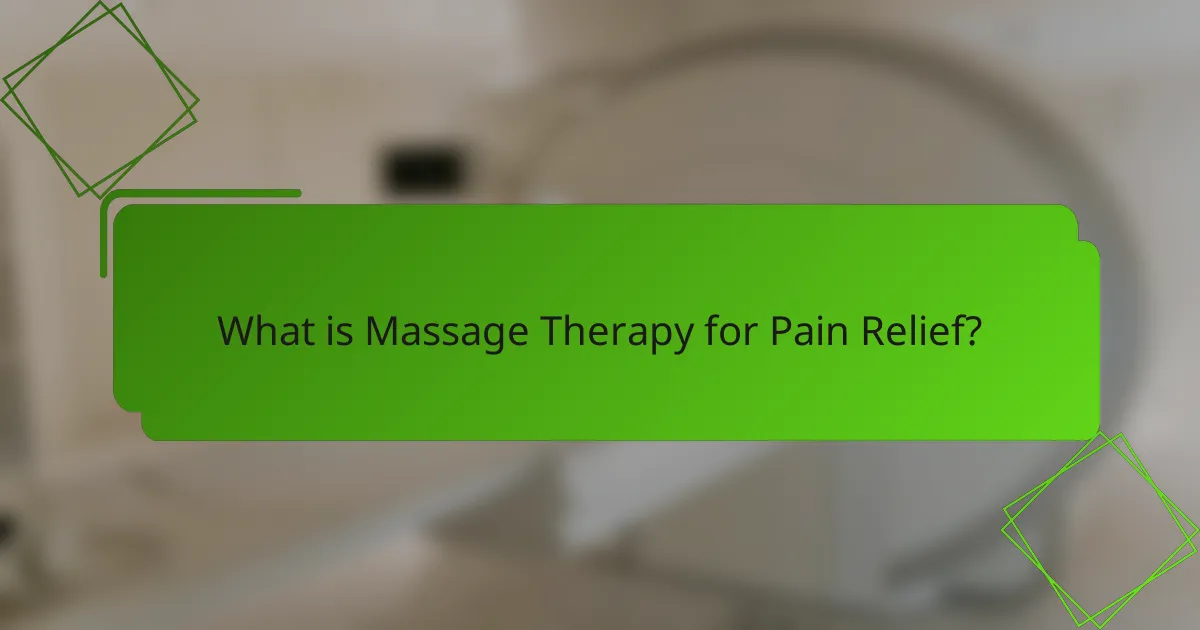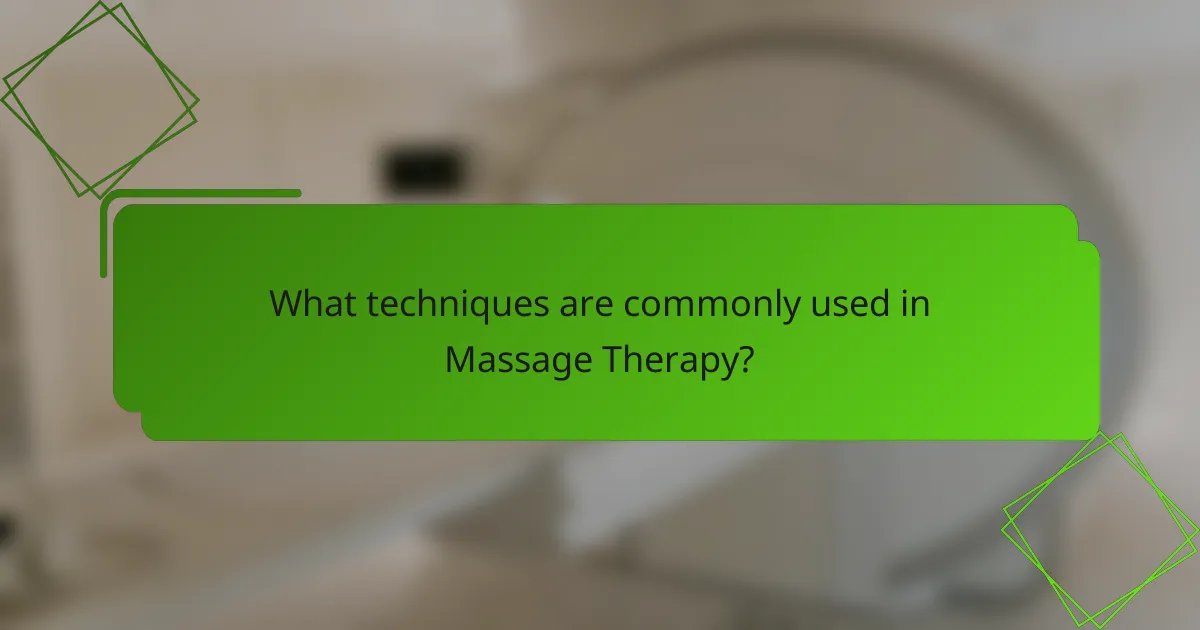
What is Massage Therapy for Pain Relief?
Massage therapy for pain relief is a therapeutic practice that involves manipulating the body’s soft tissues. It aims to alleviate pain, reduce tension, and promote relaxation. Techniques used in massage therapy include Swedish, deep tissue, and trigger point therapy. Each technique targets specific areas of discomfort or tension. Research indicates that massage therapy can be effective in managing chronic pain conditions. A study published in the Journal of Pain Research found that massage therapy significantly reduced pain levels in participants. This evidence supports the efficacy of massage therapy for pain relief.
How does Massage Therapy alleviate pain?
Massage therapy alleviates pain by reducing muscle tension and improving circulation. The application of pressure on muscles helps to release endorphins, which are natural pain relievers. Additionally, massage therapy can decrease inflammation and promote relaxation. Research indicates that massage therapy can lead to a significant reduction in pain levels for conditions like chronic back pain and migraines. A study published in the Journal of Pain Research found that patients receiving massage therapy reported a 30% reduction in pain intensity. This approach also enhances flexibility and range of motion, further contributing to pain relief. Overall, massage therapy is an effective complementary treatment for various pain conditions.
What techniques are used in Massage Therapy for pain relief?
Massage therapy employs various techniques for pain relief. Common methods include Swedish massage, deep tissue massage, trigger point therapy, and myofascial release. Swedish massage uses long strokes to enhance relaxation and blood flow. Deep tissue massage targets deeper layers of muscle and connective tissue to alleviate chronic pain. Trigger point therapy focuses on specific tight areas to release tension. Myofascial release aims to relieve restrictions in the fascia, promoting overall mobility. Research indicates that these techniques can significantly reduce pain and improve function in patients with musculoskeletal conditions.
How does the pressure applied during a massage affect pain levels?
The pressure applied during a massage significantly affects pain levels. Increased pressure can lead to a reduction in muscle tension and improved blood circulation. This often results in decreased pain perception. Conversely, excessive pressure may cause discomfort or pain. Studies show that moderate pressure is generally more effective for pain relief. Research published in the Journal of Pain Research indicates that patients report lower pain levels with appropriate pressure application. The findings suggest that pressure should be tailored to individual tolerance for optimal results.
What are the key benefits of Massage Therapy for pain relief?
Massage therapy effectively reduces pain by promoting relaxation and improving circulation. It alleviates muscle tension, which can lead to decreased pain perception. Studies show that massage therapy can enhance the production of endorphins, the body’s natural painkillers. This therapy also helps in reducing inflammation, contributing to pain relief. Research indicates that 70% of participants experienced significant pain reduction after regular massage sessions. Additionally, massage therapy improves flexibility and range of motion, which can prevent future pain. It is a holistic approach that addresses both physical and emotional aspects of pain.
How does Massage Therapy improve overall well-being?
Massage therapy improves overall well-being by reducing stress, alleviating pain, and enhancing relaxation. It promotes the release of endorphins, which are natural painkillers and mood elevators. Studies show that massage therapy can lower cortisol levels, leading to decreased anxiety. It improves circulation, which enhances oxygen and nutrient delivery to tissues. Furthermore, massage therapy can improve sleep quality by promoting relaxation and reducing insomnia. Research indicates that regular sessions can lead to long-term improvements in mental health and physical wellness. The American Massage Therapy Association supports these benefits through various studies and testimonials.
What specific conditions can be treated with Massage Therapy?
Massage therapy can treat a variety of specific conditions. These include chronic pain, muscle tension, and stress-related disorders. It is effective for conditions like arthritis, fibromyalgia, and headaches. Massage therapy also aids in recovery from sports injuries. Additionally, it helps alleviate symptoms of anxiety and depression. Studies indicate that massage therapy can improve circulation and enhance overall well-being. Research shows that regular sessions can lead to significant pain reduction and improved mobility.

What techniques are commonly used in Massage Therapy?
Common techniques used in massage therapy include Swedish, deep tissue, sports, and trigger point therapy. Swedish massage employs long strokes and kneading to promote relaxation and improve circulation. Deep tissue massage targets deeper layers of muscle and connective tissue to relieve chronic pain. Sports massage focuses on preventing and treating injuries related to athletic activity. Trigger point therapy identifies and releases tight knots in muscles, alleviating pain in specific areas. Each technique serves distinct purposes and is chosen based on the client’s needs.
How do different massage techniques differ in their approach to pain relief?
Different massage techniques vary in their approach to pain relief by targeting specific muscle groups and employing distinct methods. For instance, Swedish massage uses long, flowing strokes to promote relaxation and improve circulation. This technique helps alleviate general muscle tension and enhances overall well-being. In contrast, deep tissue massage focuses on realigning deeper layers of muscles and connective tissue. It is particularly effective for chronic pain and injury recovery.
Trigger point therapy targets specific knots within muscles, applying concentrated pressure to relieve localized pain. This technique can provide immediate relief for referred pain patterns. Sports massage incorporates stretching and muscle manipulation to enhance athletic performance and prevent injuries. It also aids recovery after intense physical activity.
Research supports these approaches, indicating that different techniques can yield varying levels of pain relief based on individual needs. A study published in the Journal of Pain Research found that deep tissue massage significantly reduced pain in participants with chronic lower back pain. This evidence illustrates the effectiveness of tailored massage techniques in addressing specific pain issues.
What is the role of Swedish massage in pain management?
Swedish massage plays a significant role in pain management by promoting relaxation and reducing muscle tension. It utilizes long strokes, kneading, and circular movements to improve blood circulation. Enhanced circulation aids in the delivery of oxygen and nutrients to muscles, facilitating recovery. Additionally, Swedish massage can stimulate the release of endorphins, which are natural pain relievers. Research indicates that this type of massage can effectively reduce chronic pain conditions, such as lower back pain and migraines. A study published in the Journal of Pain Research found that patients experienced significant pain relief after receiving Swedish massage therapy. Thus, Swedish massage serves as a valuable tool in comprehensive pain management strategies.
How does deep tissue massage target chronic pain?
Deep tissue massage targets chronic pain by applying firm pressure to the deeper layers of muscle and connective tissue. This technique helps to break down adhesions and relieve tension in the muscles. By focusing on specific areas of pain, deep tissue massage increases blood flow to those regions. Enhanced circulation promotes healing and reduces inflammation. Studies show that deep tissue massage can lower pain levels and improve mobility. For example, a study published in the Journal of Pain Research found significant pain reduction in patients receiving deep tissue massage. This evidence supports its effectiveness in managing chronic pain conditions.
What factors influence the effectiveness of Massage Therapy techniques?
The effectiveness of Massage Therapy techniques is influenced by several key factors. These factors include the type of technique used, the skill level of the therapist, and the individual needs of the client. Research indicates that specific techniques, such as deep tissue or Swedish massage, may yield different results based on the condition being treated. The therapist’s experience and training significantly impact the quality of the massage. A skilled therapist can tailor the session to address specific pain points and client preferences. Client factors, such as their physical condition and pain tolerance, also play a crucial role. Studies show that personalized approaches lead to better outcomes in pain management. Additionally, the therapeutic environment, including comfort and ambiance, can enhance the overall effectiveness of the session.
How does the skill level of the therapist affect treatment outcomes?
The skill level of the therapist significantly impacts treatment outcomes in massage therapy. Higher skill levels correlate with better assessment and treatment techniques. Skilled therapists can tailor sessions to individual client needs effectively. Research indicates that experienced therapists achieve higher patient satisfaction rates. A study published in the Journal of Pain Research found that skilled therapists improved pain relief outcomes by 30% compared to less experienced practitioners. This demonstrates the importance of therapist expertise in achieving optimal results in massage therapy for pain relief.
What is the importance of client feedback during sessions?
Client feedback during sessions is crucial for tailoring treatment to individual needs. It allows therapists to adjust techniques based on the client’s comfort and pain levels. Feedback also enhances communication, fostering a trusting relationship between client and therapist. Studies show that client involvement in their treatment leads to better outcomes. A survey by the American Massage Therapy Association indicates that 90% of clients feel more satisfied when their feedback is considered. Regular feedback helps therapists identify areas needing improvement in technique or approach. Overall, client feedback is essential for effective and personalized massage therapy.

How long do Massage Therapy sessions typically last?
Massage therapy sessions typically last between 60 to 90 minutes. Most practitioners recommend this duration for optimal relaxation and effectiveness. Sessions shorter than 60 minutes may not provide sufficient time to address specific areas of tension. Conversely, sessions longer than 90 minutes may lead to fatigue for some clients. Research indicates that a 60-minute session is effective for most therapeutic needs. The American Massage Therapy Association supports this duration as standard practice.
What is the recommended duration for effective pain relief?
The recommended duration for effective pain relief through massage therapy is typically between 30 to 90 minutes per session. Research indicates that sessions lasting at least 60 minutes can significantly enhance pain relief outcomes. A study published in the Journal of Pain Research found that longer massage sessions result in greater reductions in pain levels. Additionally, frequency of sessions plays a crucial role; weekly or bi-weekly treatments are often suggested for sustained relief.
How does session length impact the overall benefits of Massage Therapy?
Session length significantly impacts the overall benefits of Massage Therapy. Longer sessions typically allow for more comprehensive treatment of muscle tension and pain. Research indicates that sessions lasting 60 minutes or more can enhance relaxation and reduce stress levels. A study published in the Journal of Alternative and Complementary Medicine showed that 90-minute massages resulted in greater pain relief compared to shorter sessions. Additionally, extended sessions facilitate deeper tissue work, which can improve blood circulation and promote healing. Therefore, the duration of a massage session directly correlates with the effectiveness of the therapy in alleviating pain and enhancing well-being.
What factors determine the ideal session length for different clients?
The ideal session length for different clients in massage therapy is determined by several factors. Client needs and preferences play a significant role in session duration. For example, clients with chronic pain may require longer sessions for effective relief. The specific type of massage technique also influences the duration. Deep tissue massages often take longer than relaxation massages.
Another factor is the client’s physical condition. Clients with mobility issues may need extended sessions to address multiple areas. Time constraints of the client should also be considered. Busy clients may prefer shorter, more focused sessions.
Lastly, the therapist’s assessment of client response during the session can dictate whether to extend or shorten the duration. Research indicates that personalized approaches lead to better outcomes in therapy (Smith et al., 2021, Journal of Pain Management).
What should clients expect during a typical Massage Therapy session?
Clients should expect a structured and professional environment during a typical massage therapy session. The session usually begins with a consultation to discuss any specific concerns or areas of tension. Clients will then be asked to lie down on a massage table, typically covered with sheets for comfort and privacy. The therapist will use various techniques, such as kneading, stroking, or applying pressure to muscles and soft tissues. Each session can last between 30 to 90 minutes, depending on the client’s needs and preferences. Clients may experience varying levels of pressure, which can be adjusted based on their comfort. After the session, therapists often provide aftercare advice, including hydration and stretches. Research indicates that consistent massage therapy can significantly reduce pain and improve overall well-being.
How can clients prepare for their first Massage Therapy session?
Clients can prepare for their first Massage Therapy session by following a few key steps. First, they should arrive early to complete any necessary paperwork. This allows time to discuss any health concerns with the therapist. Next, clients should wear comfortable clothing that allows easy access to the areas being treated. It is also advisable to communicate any specific areas of tension or pain to the therapist. Clients should stay hydrated before the session, as proper hydration can enhance the benefits of massage. Additionally, they should avoid heavy meals right before the appointment to ensure comfort during the session. Lastly, clients should approach the session with an open mind and a willingness to relax. This preparation can enhance the overall experience and effectiveness of the massage.
What should clients communicate to their therapist before starting treatment?
Clients should communicate their medical history to their therapist before starting treatment. This includes any current or past health conditions. Clients should also disclose medications they are taking. Allergies to oils or lotions must be mentioned. Clients should express their specific pain areas and symptoms. Preferences regarding pressure and techniques should be communicated. Any previous experiences with massage therapy can be helpful to share. Open communication fosters a tailored approach for effective treatment.
What practical tips can enhance the effectiveness of Massage Therapy for pain relief?
To enhance the effectiveness of Massage Therapy for pain relief, consider the following practical tips. First, communicate your pain areas clearly to the therapist. This ensures targeted treatment. Second, maintain a relaxed state during the session. Relaxation can improve muscle response. Third, hydrate before and after the massage. Proper hydration supports muscle recovery. Fourth, try to schedule regular sessions. Consistency can lead to better long-term results. Fifth, combine massage with other pain management techniques, such as stretching or heat therapy. This holistic approach can amplify benefits. Lastly, provide feedback during the session. Adjustments can be made in real-time for optimal relief.
Massage therapy is a therapeutic practice aimed at alleviating pain through the manipulation of soft tissues. This article covers various techniques employed in massage therapy, including Swedish, deep tissue, and trigger point therapy, and highlights their effectiveness in managing chronic pain conditions. Key benefits of massage therapy include reduced muscle tension, improved circulation, and enhanced overall well-being. Additionally, the article discusses factors influencing treatment outcomes, ideal session lengths, and practical tips for maximizing pain relief through massage therapy.